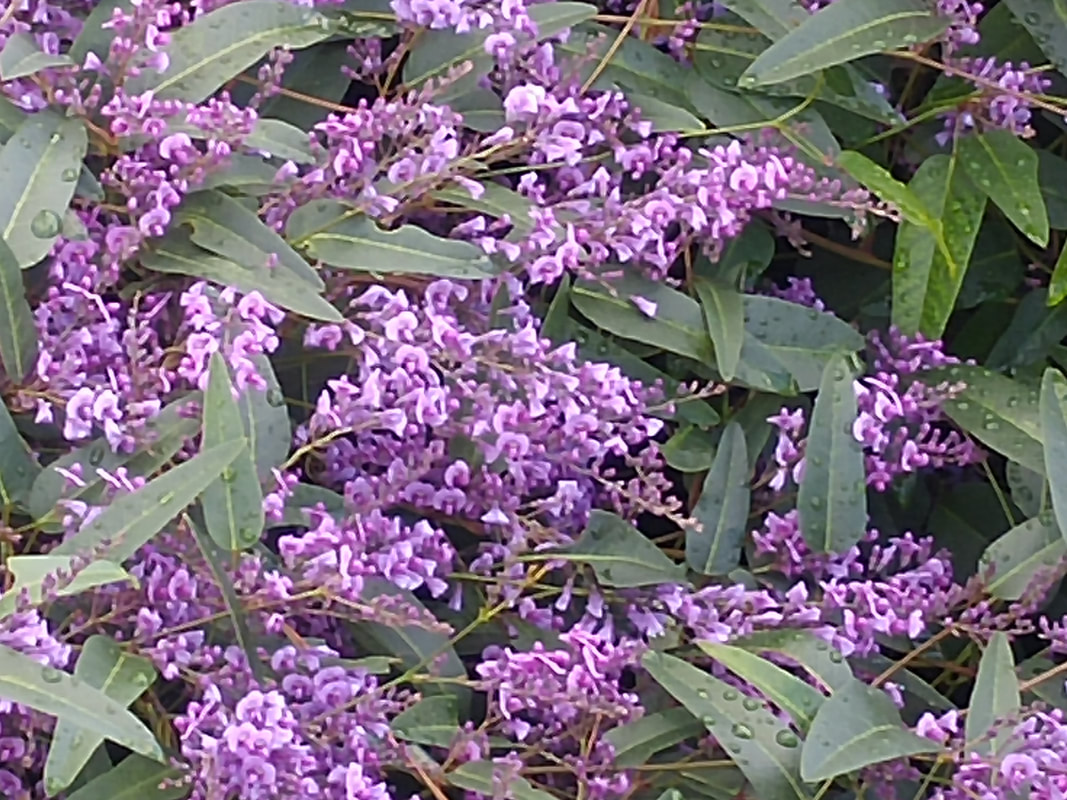| | With more glorious rain promised from now through the weekend, I’m wallowing in my “nasturtium ocean”, with its two-foot-tall "waves" and blossoms just beginning to surmount the 9-inch wide leaves. Talk about plants loving the moisture! And tiny carrots are beginning to join the lettuce, spinach, bok choy, cilantro and parsley for our nightly salads. Even a potato or two from remnants of last year's planting that I’d missed harvesting and had come up this year through the now-cilantro bed. Yum for both eyes and mouth! Yesterday afternoon’s talk on the telephone was interrupted by streaks of bright blue outside my window when two peacocks moseyed up the ramp to the garden, so I followed with camera in hand and got a couple of shots as they left our property. Calls to the Arboretum and the Humane Society elicited these results: Arboretum peacock escapees from years ago have become “feral”, traveling through underground culverts as well as walking and flying to far-flung locations. Because they’re now wild, they shouldn’t be fed or even approached closely. This morning, when retrieving the newspaper, I found white blotches on the driveway pavement below a palm tree, so perhaps they’d spent the night after leaving our property. Another “wildlife” sighting was a hummingbird nest. After a couple days of being “buzzed” as we passed one bush near our front door, we found a nest with a couple of eggs. We’ve made a point to use another door, to allow Mom to stay sitting on her eggs without our disruption. Both daytime temperatures of high 50s to low 60s, and nighttime temperatures of mid-to-high 40s to low 50s are conducive to both seeding and transplanting. With the soil staying moist between each rainstorm, better germination is a likely result. So keep sowing – especially wildflowers! – and transplanting spring edibles and ornamentals. The low 40s even contribute to the accumulation of low-chill hours for our dormant fruit trees. Since we haven’t had over-70s daytime degrees lately (which cancel out below-41-degree chill hours), these staying-low temperatures may indeed add up to enough hours to have our trees feel they’ve had sufficient to blossom and set fruit later this spring. Hopefully the chilliness and moisture will last through February to keep the trees “asleep” and dormant longer so they'll gain energy for their summer exertions to come. See February Monthly Tips for tasks to consider – when you can finally get out into the garden but not compact the soil by walking and digging! |
|
5 Comments
Paula Sirola
2/13/2019 07:00:30 pm
Love the photos of your garden and to learn the names of plants I see all around! The hummingbird nest (what a great shot!) reminds me of when we had one here at our house, too.
Reply
2/14/2019 10:13:48 am
Hi, Paula -- I'm so glad they bring back fond memories!
Reply
2/14/2019 12:01:04 pm
1. The Friends Family Community Garden will kick off it's second gardening year on February 24. If anyone is interested in planting a bed for their personal use contact Philip Cox 626-215-3299 or [email protected]. Space is limited but all are welcome.
Reply
Jack Sanders
7/3/2019 07:41:49 pm
Yvonne thanks for sharing the beauties of your gardens with us. I think that
Reply
Yvonne Savio
7/3/2019 11:05:40 pm
How nice of you, Jack! Certainly I love playing in the dirt in my garden with the resulting wonderful produce and posies! Glad to share them with you!
Reply
Leave a Reply. |
Categories |













 RSS Feed
RSS Feed